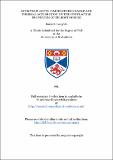Files in this item
Effects of acute temperature change and thermal acclimation on the contractile properties of teleost muscle
Item metadata
| dc.contributor.advisor | Johnston, Ian A. | |
| dc.contributor.author | Langfeld, Karen S. | |
| dc.coverage.spatial | 172 p. | en_US |
| dc.date.accessioned | 2018-07-05T13:20:12Z | |
| dc.date.available | 2018-07-05T13:20:12Z | |
| dc.date.issued | 1991 | |
| dc.identifier.uri | https://hdl.handle.net/10023/14994 | |
| dc.description.abstract | Chapter 1 - General Introduction. Part I reviews the structure and function of fish muscle, including fibre orientation, the properties of different muscle fibre types and the recruitment of muscle fibres during swimming. Part II concerns the effects of acute temperature changes on fish muscle and describes a variety of mechanisms underlying temperature adaptation, with particular emphasis on the mechanical performance of fish muscle. Chapter 2 - Temperature and the mechanical properties of live muscle fibres from the teleost Myoxocephalus scorpius. Small bundles of fast fibres were isolated from the myotomal muscle of the teleost Myoxocephalus scorpius. The temperature dependence of isometric contractile properties and the force-velocity (P-V) relation were studied. Fibres were found to deteriorate above 18°, and the force plateau during tetanic stimulation was not maintained above 15°. Twitch and tetanic tension (Po) showed optima at around 8°. Force-velocity curves were fitted using either Hill's hyperbolic equation or a hyperbolic-linear (hyp-lin) equation. The best fit to the data was provided by the hyp-1in equation, which gave consistently higher values for unloaded contraction velocity (Vmax): 4.3, 8.1 and 9.5 muscle lengths s-1 at °, 8°, and 12° respectively. Both isometric and isotonic data from live fibres was compared with skinned fibres and live fibres from other vertebrates. The P-V relation was found to become progressively more curved at higher temperatures. Muscle power output calculated from the hyp-lin equation was 124 Wkg-1 at ° and 256 Wkg-1 at 8°. Curves normalised for Po and Vmax at each temperature show that the change in curvature is sufficient to increase the relative power output of the muscle by around 15% on decreasing the temperature from 8° to °. Chapter 3 - The myology of the pectoral fin of the common carp Cyprinus carpio L. and variation in fibre composition with temperature acclimation. Common carp (Cyprinus carpio L.) were acclimated to either 8° or 20° for 8 weeks (12h light:12h dark). The myology and skeletal structure of the pectoral assemblage of the carp was studied. Cross-sections of the entire assemblage were taken for histochemistry in order to determine the distribution of fibre types within the musculature. Examination of the fibre diameter range data reveals a larger number of smaller slow fibres in the muscle of 8° C-acclimated fish, commensurate with a hypothesis that the slow fibre mass is proliferating during cold-acclimation by producing new slow fibres. Chapter 4 - Temperature acclimation in the common carp: force-velocity characteristics and myosin subunit composition of slow muscle fibres. Common carp were acclimated to either 8° or 20° for 6-12 weeks (12h light:12h dark). Bundles of 20-50 fibres were isolated from the superficial region of the pectoral fin abductor superficialis muscle. Histochemical studies showed preparations to contain 93-100% slow muscle fibres. The maximum tetanic tension (Po) produced by fibre bundles was similar when measured at the acclimation temperature of each group. Chapter 5 - General Discussion The results detailed in this thesis are discussed in relation to the effects of temperature on fish swimming. Recent developments in technique are described and some suggestions for further work using these techniques are outlined. | en_US |
| dc.language.iso | en | en_US |
| dc.publisher | University of St Andrews | |
| dc.subject.lcc | QL638.P7L2 | en |
| dc.subject.lcsh | Teleostean fish biology | en |
| dc.title | Effects of acute temperature change and thermal acclimation on the contractile properties of teleost muscle | en_US |
| dc.type | Thesis | en_US |
| dc.contributor.sponsor | Natural Environment Research Council (NERC) | en_US |
| dc.type.qualificationlevel | Doctoral | en_US |
| dc.type.qualificationname | PhD Doctor of Philosophy | en_US |
| dc.publisher.institution | The University of St Andrews | en_US |
This item appears in the following Collection(s)
Items in the St Andrews Research Repository are protected by copyright, with all rights reserved, unless otherwise indicated.

